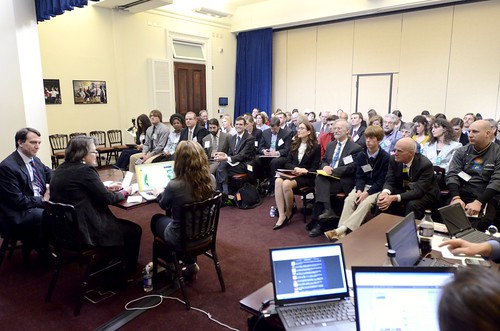
Yesterday, I had my first-ever “virtual conversation.” It included Jon Carson, Director of Public Engagement for the White House; Sam Kass, Senior White House Advisor on Food Policy, and 60 other local food practitioners. We came together to talk about the new Know Your Farmer, Know Your Food Compass and were joined “virtually” by hundreds of others using the Twitter hashtag #KYF2. The result? An exciting and inspirational conversation about USDA’s work on local and regional food systems involving people from around the country.
We looked at the Compass map (I was even able to show Jon some of the projects USDA supports in his home state of Wisconsin). We explored each of the seven themes in the Know Your Farmer Compass: local food infrastructure, stewardship and local food, local meat and poultry, farm to institution, healthy food access, careers in agriculture, and local food knowledge. Participants in the room shared stories while folks on Twitter asked questions. We talked about the work USDA has done so far in local and regional food systems and the opportunities that lie ahead.
You can view the entire conversation online and hear directly from people engaged in building strong local and regional food systems in their communities. People like Orren Fox, a teenager from Massachusetts, who has been raising chickens and bees since he was nine. He told us about his beekeeping operation and gave us sage advice about getting kids involved early in agriculture by engaging them in farming-related clubs and activities.
David Marvel, a farmer in Delaware, talked about his work to connect farmers with institutional markets and the opportunities these relationships hold for farmers across the country.
Amanda Obourne of EcoTrust in Portland described how Food-hub.org is helping local farmers and buyers find each other across the Pacific northwest and how they are collaborating to develop effective distribution solutions.
Tyler Butler of Butler’s Orchard – which I visited last week – told us about his family farm in Maryland and how he uses high tunnels, or temporary greenhouses, to diversify his product offerings and expand his growing season.
Their stories are just the tip of the iceberg. Read the Know Your Farmer Compass to find out about USDA’s work in local and regional food systems and how you can tap into these resources. Search the map to find projects in your state. And continue the conversation about local and regional foods with your friends, your family, your community and your social network via twitter using #KYF2.
“If I could just give a shout out to everyone tweeting with us here today,” said Carson at the event,
“I don’t think we’ve ever had this type of participation before. Keep tweeting.”
